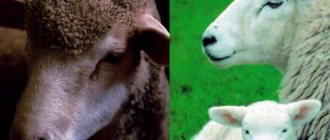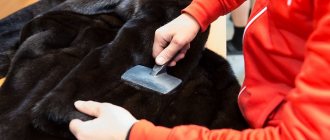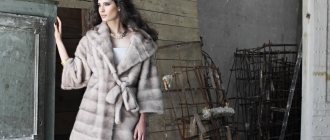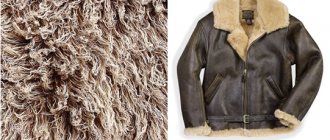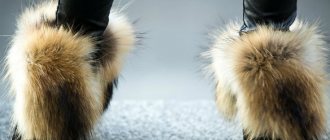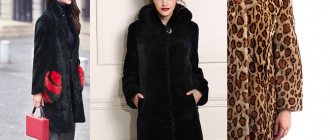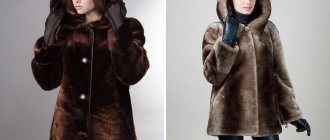What is the difference between sheepskin and mouton? Sheepskin or mouton?
The lush and curly wool of a sheep produces several types of fur used for making fur coats and other products. Depending on the processing method, sheep fur is divided into sheepskin, mouton, astrakhan fur and astrakhan fur.
Sheepskin is the fur of an adult sheep. It was used for protection against frost several centuries ago. The wear resistance of sheepskin products is 55% of the accepted standard, so a fur coat or hat will be worn for at least 6 seasons.
Products made from sheepskin fur are distinguished by their versatility. Modern technologies and processing methods triple the positive properties of this fur. The world's best designers are working on the development of models of fur coats, sheepskin coats, and sheepskin coats. If previously sheepskin products were considered clothing intended for commoners, they are now the standard of fashion trends.
Mouton is the same sheep fur that has been specially treated with formaldehyde. Mouton is produced only in Russia, so it can be called Russian fur, which is absolutely not afraid of any natural vicissitudes. In rain and wet snow, outerwear made from mouton does not get wet and does not lose its basic qualities.
Unlike sheepskin, products made from mouton will last twice as long. The color range of mouton fur coats ranges from bright white to black.
Mouton fur coats can be compared in quality to fox fur coats; they are second only to otter fur coats. However, the price of products made from mouton is quite affordable for most buyers, this is explained by the simple production method and the presence of fur in excess quantities.
Russia is a country where most regions have harsh winters, so Russian buyers are the main consumers of Mouton products. The tailoring of the models is designed for different age groups of consumers, the finishing can also be different.
Collections of mouton fur coats are created not only for women. The stronger half of humanity also prefers to buy sheepskin coats made from mouton. This is due to practicality, convenience, and wear resistance.
Types of sheepskin by fleece type
Depending on the type of fleece, sheepskins are divided into thin, semi-thin and semi-thick. The first type is characterized by thick, uniform hair 6 cm or more in length. Hair tone should be at least 60 (23.1-25.0 microns). Australian Merino sheep are a breed of fine-woven sheep.
Semi-fine wool has a fineness of 50-58 microns (25.1-31 microns). An exception is the fur of the Tsigai sheep, the wool quality of which can be 46 (34.1–37 microns). Hair is distinguished by thickness, elasticity, medium and strong viscosity, and staple structure.
The finely dispersed, coarse-woven variety has heterogeneous suspensions with a staple structure. It contains a large amount of lining fluff and has coarse and long hair on the runway.
Fur sheepskin is worn with the fur on the outside, and fur sheepskin is worn with the fur on the inside. The latter are intended for sheepskin coats, vests and jackets with fur on the reverse side. These types of skins must be endowed with high-quality fur, since it is located on the front side of the product.
Sheepskin jackets are divided into three types: Romanov, Russian and Steppe. Romanov sheepskins are made from Romanov sheepskins and are considered the best. They have a gray-blue color due to the harmonious combination of white fluff and black spiky hair. Russian sheepskin coats are made from raising rough-woven animals, and steppe sheepskins are made from raising rough-woven sheep and Karakul pigs. Steppe and Russian sheepskin skins are divided into white, gray and colored.
There is also sheepskin leather, which has many shortcomings on the fur side. Its quality does not allow it to be used for the same purposes as fur and fur varieties, but it is actively used in the manufacture of shoes, accessories, jackets and leather hats.
Mouton and tsigeika difference. What is the difference between mouton coats and tiger coats?
Both mouton and tsigeika are essentially sheepskin, but there is a significant difference between them. Tsigei fur products were made from shorn and dyed fur from sheep of a special breed - Tsigei. Currently, this breed is no longer bred in Russia and imported raw materials are used for sewing outerwear - sheep skins grown in Australia, Mongolia, China and other countries. Mouton, the word from French as “ram”, is sheepskin processed in a special way, and, since the technology involves the use of formaldehyde, this method is considered harmful and is not used anywhere except Russia. For the production of mouton, the skins of only certain breeds of sheep grown in Australia and New Zealand are also used. They are distinguished by high thermal insulation properties and super strength, and after processing these qualities are not lost, but only enhanced.
Otter fur is considered the most durable; a fur coat made from it will last about 20 years; a beaver or mouton fur coat will last 18 years, sable - 12 years, mink - 10 years.
The processing of these hides includes traditional stages - first they go through the fleshing stage and are cleaned of residual fat and muscle tissue, then the felting stage - they are rotated in a vibrating drum to give the flesh softness. After this, the skins are stretched on a special table so that they become larger in area. A special technological stage - formalin treatment - turns ordinary sheepskin into a mouton. After this, the fur becomes moisture-resistant and especially durable, and poisonous formaldehyde is specially cleaned and removed from the surface of the skin. The fur is trimmed and smoothed in a special way, after which the mouton takes on its own appearance, and only a specialist can recognize it as ordinary sheepskin.
Mouton is characterized by a high density of pile, it does not pill and retains its presentation even with daily use.
Models
A wide variety of models are sewn from mouton: coats, jackets, classic coats and fur coats. Fur lends itself well to any coloring. Therefore, along with the classic shades - brown, beige, gray and black, you can find models in blue, blue and even red.
Tsigeika can be found in different lengths. The car owner will most likely choose a short kurta for himself. For those who love hiking, a long fur coat is perfect. A model with a hood will best protect you from bad weather.
Nowadays cross-cut fur coats are in fashion. They can be recognized by the horizontal arrangement of fur stripes. Ciguey ones look very original, thanks to the selection of interesting shades.
Straight, trapezoidal and fitted silhouettes remain the current models in the zipper design. Fur coats are often made with belts that neatly highlight the female figure.
A cropped mouton looks very unusual. For this purpose, fur with a thick down and noticeable curls is used. After shearing, the sheepskin is completely unrecognizable, as it becomes like astrakhan fur. The plasticity of sheared fur allows us to produce models of the most complex cuts. In cropped mouton, popular models are straight-cut coats, made in the best classical traditions: with a turn-down collar and buttons. There are fitted models, as well as products with slightly shortened sleeves in size 7/8. The product can be with a stand-up collar and a Chanel collar. On the trapezoidal coat you can see trims from other furs.
When purchasing a sheared mouton, many buyers are concerned about the quality of the fur. Even after cutting, it does not lose its properties, maintaining the warmth and durability of the cover. Sometimes you can find models in which the fur is not completely cut, but in lines and patterns.
The fur retains its qualities even after it is trimmed: the short pile does not roll off, does not lose its shiny appearance, and is also easy to clean. The cropped models are just as warm as regular shorts. Manufacturers like to decorate mouton fur coats with leather inserts and belts. Products with collars made of mink, arctic fox or silver fox fur look luxurious.
Strong hooks are used as fasteners on fur coats, and buttons look best on coats.
What is the difference between astragan and mouton. All about the mouton. Frequently Astragan
In the “mouton” section of our catalog you can find astragan fur coats. What kind of fur is this? This is one of the most frequently asked questions to us lately. We answer this in a separate article.
Astragan is a type of mouton. It represents the highest quality sheepskin of a special grade. To obtain it, special processing of semi-finished fur products is used. Initially, the first necessary condition is the presence of sheepskin with a strong curl of hair and a densely stuffed down. The skin is cut much shorter (0.5 - 0.7 cm) than what happens when cutting a regular mouton. Thanks to the desired curl of the hair, with such a short haircut, the desired effect is obtained, visually very reminiscent of broadtail.
We sorted out the appearance. Let's see what other benefits astragan has. It is lighter than the 'Mechs in its group. This time. At the same time, it is in no way inferior to it in terms of heat conservation. In terms of wearability it is also better, despite the fact that a simple mouton is also very wearable. That's two. But there is also another side to the coin. Fur coats made from these unique skins are more expensive than similar products. The price difference ranges from 10 to 30%. Our factory can sew any model of fur coat from the catalog, as well as an exclusive one from astragan. The choice is yours!
What is sheepskin?
Sheepskin is a tanned sheepskin, taken from adults or young animals over 6 months of age. The dressing of the hide takes place over several days and goes through the following stages: primary dressing, soaking, fleshing, soaking in solution, pickling, tanning, fatliquoring, pressing, drying and grinding. The final stage involves stretching the skin, straightening the edges, combing and trimming the fur.
Sheep skin dressing
The classification of hides occurs at the raw material stage. They are grouped according to the following characteristics:
- age of sheep;
- breed;
- number of defects;
- appointment;
- length and quality of wool.
Astrakhan
The list of characteristics affects the cost of the skin or the finished product. Sheepskin has many varieties, among which the most famous are mouton, astragan, and tsigeika. Karakul is also sheep fur, but it is the skin of newborn lambs.
Mouton for astrakhan fur. Karakul (fur)
Karakul is literally translated from Turkic as black lake (kara kul) - skin with fur, removed from lambs of the Karakul breed 1-3 days after birth, when their wool is distinguished by thick, elastic, silky hair, forming curls of various shapes and sizes.
Initially, only natural skins of lambs of the Karakul breed, bred in ancient times in Central Asia, were called karakul. However, in the 1960s, faux fur with a very short, silky pile that fits tightly to the base fabric, forming a relief moiré pattern on the surface, also began to be called astrakhan. The word “karakul” itself is of Turkic origin and literally means “black lake,” although astrakhan can be of different colors (fawn, gray). In Western European languages, astrakhan is called “Astrakhan”, after the name of the main trading center that was once engaged in the trade of astrakhan, now the Russian city of Astrakhan.
Astrakhan fur is one of the most popular types of fur on the market. The ancestor of all types of current Karakul sheep is considered to be the Uzbek Karakul sheep. This breed of sheep was very popular among the peoples of Central Asia due to its unpretentiousness and excellent adaptability to semi-desert conditions. In the Middle Ages, trade caravans carried karakul skins from Bukhara and Khorezm along the entire Silk Road all the way to the Mediterranean, from where they dispersed throughout Europe.
All about the mouton. How to choose a fur coat from a mouton - tips
The great demand for mouton fur is due to its wear resistance. At the first stage, fashionable mouton fur coats are processed according to the type of preservation. Therefore, by choosing such clothes, you guarantee a stylish look and a high-quality wardrobe for up to ten seasons. But in order for beautiful mouton fur coats to really serve for a long time and not lose their sophisticated appearance, you need to know how to choose the right model. Stylists recommend adhering to the following tips:
- squeeze the fur. A couple of seconds after you release the fur, it should return to its original smooth appearance. Otherwise, you are faced with a low-quality product;
- run your hand against the growth of the pile. If you have already found the answer to the question, a mouton is someone’s fur, then you know that the given direction of the pile does not break or wrinkle under any mechanical influences;
- wipe the fur with a light-colored rag. This action will allow you to understand whether the item is fading, which is excluded when choosing a quality product;
- inspect the back of the product. The skin on the inside should be intact without scratches or cracks, and its color should be light milky;
- pay attention to the seams. In low-quality models, joints are often glued. Such clothes will fall apart after the first snow or rain. Make sure the seams are topstitched.
How to evaluate quality?
You should immediately pay attention to the appearance. Mouton is shiny and soft to the touch. It is sometimes confused with sheared mink or beaver fur. The mouton itself is very dense, while others have fur that can be seen. In addition, the fur of a mink is stiffer to the touch, while a beaver, on the contrary, is fluffy.
To avoid any doubts, it is best to purchase the product in a specialized store. The warranty card will allow you to return the product if defects are found.
The quality of the fur must be checked by squeezing it in the palm of your hand. It should return to its original form. In low quality fur, the fibers stick together or break. To check the quality of coloring, you need to run a napkin over the surface. She must remain clean. Pay attention to the seams. If they are glued together, immediately discard such a fur coat. After the first exposure to snow or rain, the product may fall apart. The seams must be stitched, and they should not be convex. Moreover, the threads should not stick out.
Fur products made from sheep skins have not lost their popularity for many centuries due to their availability, practicality and ability to effectively retain heat. There are many varieties of sheepskin, which differ in their characteristics and appearance. Is there a difference between tsigeika and mouton? What is the difference between sheepskin coats and sheep wool products? Which is better to choose?
What is the difference between mouton and sheepskin. Mouton and sheepskin: is there a difference?
Mouton - what is it, whose fur is it? Mouton is the name given to sheep skin after certain processing. The fur is cut short and treated with formaldehyde. This substance envelops each hair and makes it resistant to moisture, frost and wind. This technology is currently used only in Russia and China. Therefore, products made from mouton are perfectly suited for the harsh Russian climate. After turning sheepskin into a mouton, the durability of the products increases significantly. Short fur is incredibly soft and pleasant to the touch, it retains heat perfectly even at very low temperatures. In addition, the pile is cut and leveled using imported equipment, and is also often dyed in order to give the product not just a marketable appearance, but to give it the opportunity to enter the category of premium products. In this case, a rich color palette is used, including classic options - snow-white or cream. Thanks to this, the finished product looks very impressive and respectable. The high density of the pile ensures that it will not curl or lose its properties even with intensive daily use. That is why first-class sheep fur is ideal for making car capes, which, in addition to a presentable appearance, also require high wear resistance. The quality of the dressing also allows you to understand how a mouton differs from a sheepskin. Mouton products are lighter, although they cost a little more. They are also easier to care for, since dust penetrates less through the dense pile, and debris does not get stuck between the fluffy piles. To maintain the magnificent appearance of such fur car covers, it is enough to shake them out and vacuum them a couple of times a month. Sheepskin and mouton are natural furs that are directly dependent on each other: without the first, there would be no second. However, not every sheepskin will eventually become a mouton, but only the most first-class!!!
Advantages
One of the main advantages of a mouton product is its hypoallergenicity. After the stages of processing, the fur becomes light and allows air to pass through well. It does not fall off in lumps, and the inner side (the reverse side of the skin) remains strong and soft for a long time. This is a valuable quality when remaking an old fur coat into a new style.
Sheepskin is very dense and retains heat well. Does not let in any wind or cold even in the most severe frosts. With proper care, a tiger fur coat can be worn for more than 10 seasons.
Mouton fur coats have not lost their high position among consumers for several years. And in this, compared to fur coats made from other furs, the main role is played by the affordable price. This fact also makes the product a big plus - even after heavy rain, the fur will not lose its properties and qualities. The product will not require complex restoration. It is enough to let the product dry well at room temperature (not on a radiator or near heating devices) and brush the fur with a soft brush.
Mouton drapes well, and fur coats, as a rule, look fashionable and feminine. The mouton pile is not felt, it feels like plush or velvet.
By the way, a high-quality mouton fur coat can be made without lining fabric. And in this form, the product perfectly withstands winter cold.
What is the difference between sheepskin and mouton. All about the mouton. Frequently So is it a mouton, a sheepskin or a sheepskin?
Mouton is one of the most affordable types of fur, and a mouton fur coat in our country is considered not a luxury, but a means of protection from frost.
In the first part of our article we will try to understand the definitions, since currently there are several names for this fur in people’s minds. And in general, which is correct, mouton or sheepskin, or maybe chicken? In fact, when we say mouton, sheepskin or sheepskin, we mean the same material - treated fur sheepskin. This is what it is officially called in the certification system of the Russian Federation. Fur sheepskin is the skins of sheep raised at home.
However, the word “mouton” is much more often used in consumer parlance. This word came to us from French and is translated as “ram”. In the classification of the animal world, the ram is not far from the sheep. According to one version, a Hungarian company called “Mutoon” at the beginning of the last century was actively exploring the European market with its sheepskin products. After the Great Patriotic War, the technology for processing sheepskin came to the Soviet Union, but the name “mouton” was ingrained in people’s memory; it is passed down from generation to generation and successfully lives to this day. Our factory decided not to break away from the people and in the catalog all products made from this fur are in the “mouton” section, although directly in the Declaration of Product Quality Conformity it is written: fur sheepskin.
Now all that remains is to figure out the name “tsigeika,” which many people also call mouton fur coats. In reality, tsigeika is an outdated name for mouton. During the Soviet era, domestic fur coats were made from the Tsigean breed of sheep. Now this breed has practically disappeared from Russia. All mouton fur coats are made from imported raw materials. But we will talk about this in detail in the following articles.
Shearling sheepskin
I would like to say a few words about such a thing as cutting fur. Sheepskin is often sheared, which allows you to get beautiful fur with a smooth surface. It is also often dyed to achieve an interesting variety of colors.
An example of such types of sheepskin processing is mouton and astragan.
A fur coat made from sheared sheepskin is lighter and not as warm, but this does not mean that it will be cold in it. Not at all! When shearing, of course, some of the fur is lost, but it is thick, full and still remains tall enough to not freeze. But astragan is cooler than ordinary mouton.
But it will fit perfectly under a coat! You can create very light and original products from sheared sheepskin; there are a lot of them in the assortment of Russian factories. In essence, it will be a warm coat, suitable for both autumn and winter.
What is the difference between sheepskin and mouton. What is tsigeika and is it different from mouton?
Despite the fact that many people call mouton fur products tsigeika fur coats, these concepts are still slightly different. Let's find out:
- Tsigeya is a dyed and shorn sheepskin based on the Tsigeya breed of sheep;
- Mouton is a refined sheepskin that has been treated with formaldehyde.
So, by mouton we mean natural sheepskin, processed in a solution such as formaldehyde. What does this processing provide:
- the fur coat becomes more wearable;
- it is more resistant to various influences;
- the product will be more durable.
These indicators make this fur better than mink, nutria or fox. The technology of processing fur with formalin is practiced mainly in Russia, but in Western countries it has been recognized as harmful to health. For this reason, fur coats from tsigeika (mouton) are not produced in other countries.
In Soviet times, Tsigeika was the name given to fur sheepskin, which was also processed through formaldehyde. But the Tsigai breed of sheep, which in Soviet times was used for the production of fur coats, is now almost non-existent in Russia. For the production of mouton fur coats, which are often called sage fur coats, foreign furs are currently used, mainly imported from Australia.
Fur coat care and proper storage
If you evaluate the wearability of a mouton on a 100-point scale, it will receive 60 points. And the highest position on this scale and, accordingly, 100 points is for the unplucked otter. A mouton product lasts on average 5 seasons, but with proper care and storage conditions – up to 9-10 seasons.
Here are the basic rules for storing fur products in the warm season, which will allow your fur coat to delight you for many seasons. A product made from a mouton should be stored in a closet - on wide wooden hangers to avoid deformation of the core. The closet should be spacious so that the fur can “breathe”; bright sunlight should not fall on it.
By following these rules, you will increase the service life of your favorite fur product.
What's the difference between mouton and sheepskin? How to distinguish natural sheepskin from artificial one
What is the difference and is there any? What is the difference?
Some buyers who choose car wraps made from natural fur from the Automuton factory ask a reasonable question: “If we compare mouton and sheepskin - what is the difference? And are there any significant differences between the two types of fur products?” To clarify and simplify the choice of product, we suggest you understand.
Let's remember the main thing
So, are sheepskin and mouton the same thing or not? To answer this tricky question, it is enough to remember that mouton is a special type of premium quality sheepskin.
Yes, a mouton can be called a sheepskin, but the best skins of Australian and New Zealand sheep are used for its production. The raw materials offered by cattle breeders are carefully selected according to many criteria - color, pile density, fineness of the skin, etc., and only 10% has a chance of later turning into a first-class product.
The initial stage of processing sheep skins is similar. To get a sheepskin, masters:
- they perform fleshing, that is, they cleanse the skin on which the pile is attached from fat and muscle fibers;
- then the flesh (the skin part of the skin) is felled - it is rolled in a vibrating drum to give the necessary softness;
- the skin is then stretched to increase its area.
A little more time passes, and the game is ready. You can sew hats, fur coats from it, and if you turn the skin out, you can make sheepskin coats. But now from the highest quality, but raw sheepskin, you can get a mouton by soaking the skin in a special solution containing formaldehyde.
The technology is used today only in Russia, since in Europe and America animal rights activists have had the strength to prove the inhumanity and cruelty of raising animals for subsequent killing and manufacturing of fur products.
Important! Both furs are completely natural, so they perfectly regulate heat exchange, providing the necessary air circulation.
Products made from sheep skins have a beneficial effect on health:
- improve blood circulation;
- normalize intracranial pressure;
- have an anti-stress effect, including helping to get rid of insomnia and lack of appetite; relieve muscle spasms;
- reduce the load on joints and spine;
- help resist colds and other infectious epidemics.
Mouton is not just valuable fur
Even very skillfully crafted sheepskin cannot compare with the surprisingly soft and shiny mouton - and this is the main visual difference between the two types of fur. “Mouton” (translated from French as “ram”) acquires such unique qualities precisely after formaldehyde treatment. It not only improves the moisture protection of fur, but also extends its service life.
On a note! Residues of formaldehyde are removed using a special technology, so buyers do not have to worry about the environmental friendliness of the products.
In addition, the pile is cut and leveled using imported equipment, and is also often dyed in order to give the product not just a marketable appearance, but to give it the opportunity to enter the category of premium products. A rich color palette is used, including the classic options - snow-white or blue-black. Thanks to this, the finished product looks very impressive and respectable.
The high density of the pile ensures that it will not curl or become covered with pellets even with intensive daily use. That is why first-class sheep fur is ideal for making car capes, which, in addition to a presentable appearance, also require high wear resistance.
What is a mouton?
Mouton is a refined sheepskin, dressed in a special way and treated with formaldehyde, which “preserves” the hairs of the wool. Mouton comes from the French word mouton and means sheepskin, ram, valuh.
Mouton is 100% natural fur of natural origin, which provides the best protection from cold, wind, moisture and other weather conditions,
allows you to maintain body temperature and protect from physical environmental influences.
The mouton gained popularity due to the positive properties of fur. Mouton is a soft, durable and very practical material. It has excellent shine, lightness, elasticity and does not pill when worn daily. For a long time it retains its excellent appearance, the pile does not break or deform.
The fibers of sheepskin fur create a natural layer of air and maintain air circulation, which has a beneficial effect on the microclimate of the body, retains heat, preventing freezing at the lowest temperatures, in harsh climates.
Content:
What is mouton made from? Mouton production technology Mouton coats - a budget option Miraculous sheepskin fur Sheepskin in modern fashion Sheepskin production History of sheepskin Sheepskin on fashion catwalks
